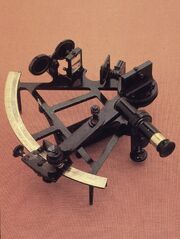
A sextant
Everything in Astronomy is strongly connected to Mathematics. There are many mathematic formulas that allow us to see how would a planet behave in special conditions. Using these formulas we can see how would a planet behave in orbit around a certain star, how would a star behave, if the target planet or moon can be terraformed and if settlers will find that planet a better or worse home then Earth is for us.
Reason
The formulas I use are not always scientific formulas. I worked with them over time, since 2002. I improved them. At that time, I was using Quattro Pro, but majority of them can be also adapted for Microsoft Excel, the most commonly used program for mathematic formulas. A scientist might argue that these formulas are not 100% correct or that there are other, far better formulas. For someone who is not too good in math, they would provide just enough data. For example, for someone who simply wants to know how would a terraformed planet behave around Barnard's Star, what is the amount of ultraviolet radiation around a white dwarf or how the sky would look from one of Saturn's moons, these formulas are just perfect. This is the reason why I decided to share them with you.
In many cases, I introduced additional, more useful units, constants and terms.
Luminosity
Maybe the most important thing that a planet needs is light. A planet orbiting a star benefits from a certain amount of light, both in visible and invisible spectra.
Solar Constant is defined as the solar (or stellar) energy output received by a planet at a specified distance (usually for Earth's orbit[1]). This is the first thing you need to find out before calculating other luminosity parameters.
Magnitude is the luminosity of a celestial body. There are a few formulas that can help us see how would the sky look from a certain planet.
Angular Size defines how you would see an object from your position. With this tool, you can calculate how would the sky look like around a giant planet with many moons.
Planetary Parameters
Main article: Planetary Parameters
There are a few basic formulas that allow us to find out what a planet would behave like, given some simple data, like mass, diameter and luminosity.
Temperature is an important feature for any planet.
Climate can be predicted by using some basic formulas.
Atmospheres
Main article: Atmosphere Parameters
Not all planets will support an atmosphere. Atmosphere around small bodies will tend to be lost in space.
Greenhouse Calculator is an add-on article that helps you fin out what is the amount of greenhouse gasses or anti-greenhouse technology you would need.
Host Stars
Main article: Stellar Parameters
There are a few formulas that allow us to see how would a star behave to its host planets. The most important factors are related to light output.